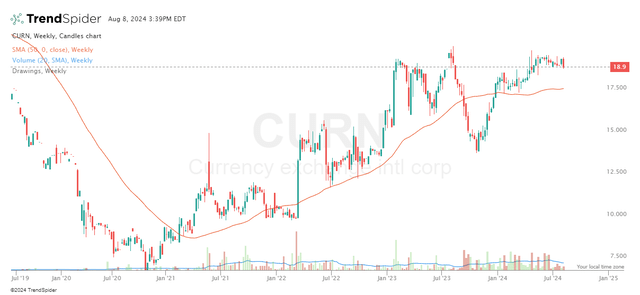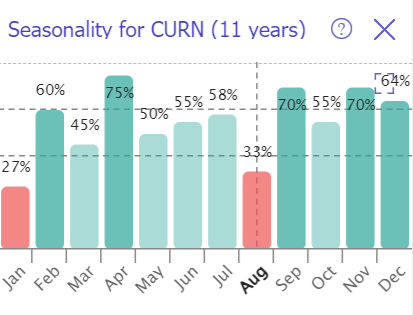Currency Exchange International: Smart Money Is Buying, And So Am I (Upgrade) (OTCMKTS:CURN)

Image Source
Currency Exchange International “CXI” (OTCPK:CURN) is a market leader in commercial banknote exchange in North America. The company also has a fast-growing software business providing FX as well as payment processing and compliance for businesses. Somewhat more recently, they’ve chartered a B2B bank (Exchange Bank of Canada) which is one of three foreign institutions licensed by the fed to distribute USD outside the U.S. For more detail on the business, see my initial investment pitch here.
I initially recommended CURN as a STRONG BUY late last year, but decided to hold off on buying shares, because I didn’t feel certain enough about the (1) future of banknotes demand and (2) the opportunities available to EBC. This was why I downgraded the company to HOLD in May. Shares have barely budged so far this year, underperforming the S&P by 6%. But based on recent results and further research, I have now built the conviction to upgrade CURN to a BUY once again. I have built a standard position in my own portfolio. Below, I outline the reasons why.
CURN stock chart (TrendSpider)
1. The Smart Money Remains Bullish
Artko Capital, Plural Investing Partners, and Greystone CM have all been invested in CURN and written up short-form theses which have been reposted to SA. But Artko does not post their returns, and Plural has underperformed the market since its inception, so this did not give me great confidence in the thesis. Add to this the fact that Plural partners has reduced their price target from $60 to $50 since Q1 2023. Given that this has remained a “three-year” price target, it also seems that the returns have been getting pushed further into the future, bringing expected annual returns from 44% (3x in 3 years) to 23% (2.5x in 4.5 years). This does not inspire great confidence.
But I am much more heartened to see continued bullishness from Greystone CM, which according to a recent pitchbook has beaten the Russell by almost 10% p.a., net of fees, since its 2019 inception. Adam Wilk, the CIO, has had a very successful run, and has held CURN as one of the fund’s top 10 positions consistently since Q1 2022, more than doubling his money in ~2.5 years. Readers interested in Greystone’s initial thesis can see the 2022 letters on their website. Here I will focus on the future prospects. In Q2 and Q4 2023, Greystone repeatedly emphasized that CURN’s real earnings power is twice its current level ($2.25/share vs. $1.17 TTM) and they expect the company to reach this level “in the next few years.” They write:
this $18/share stock will likely see its earnings power approach $2.25-2.50/share within the next few years, which is too low a valuation for the growth runway, incremental margin potential, net cash balance sheet and profitability.
In other words, Greystone remains optimistic that CXI’s profitability is primed to inflect upwards. They also highlight the downside protection, something I hadn’t fully appreciated when I first wrote:
…With the stock trading at liquidation value, our downside remains well protected, and with patience, there remains a comfortable path to 100% upside from here.
CXI has a huge cash balance ($107 net million vs. a current market cap of $119 million). While much of this is in fact inventory, necessary for normal business operations, in a true worst-case scenario, it could be liquidated at…cash value. This means that the ultimate downside risk is very low.
Finally, they note that this inflection point has been delayed:
As expected, the inflection point in CURN’s business post-COVID has come with some incremental costs which come before the eventual incremental revenues and profits from these initiatives.
Seeing that Greystone has had such a successful track record and remains bullish on CXI’s future prospects inspired me to return to the recent results and consider whether I had been too hasty in deciding that growth was not going to materialize. I concluded that my May downgrade to HOLD was premature. Here’s why:
2. Recent CEO Interview Ameliorated My Concerns
In June, CEO Randolph Pinna (a classic owner-operator, as I identified in my original pitch) did an extended interview for the MicroCap Club with Adam Wilk of Greystone. During the interview, Pinna answered some key questions.
1: The $1.4 million in “one-time” charges in Q2 were due to reconciliations required as part of the company’s migration to Oracle NetSuite ERP software. These charges really are one-time, and don’t indicate a bigger problem.
2. I had been concerned that CXI’s core business is a melting ice cube. People are not using cash as much as they used to. But as Pinna and several other recent analysts (behind paywalls) have noted, cash use has actually been increasing in the US in recent years, contrary to expectations. This is likely due to an increase in travel, for which foreign banknotes are still used. Moreover, there is ample room for CXI to continue growing by taking market share from competitors leaving the market.
3. In the payments software segment, CXI’s business is booming. Most of their revenue comes from American companies, and segment revenue in the US grew at 50% YOY in Q2. While payments currently only account for ~20% of revenue, this explosive growth shows how CXI is successfully transitioning away from – or building upon – their legacy business. This should give investors confidence that the ice cube isn’t melting too fast.
4. In the wholesale banknotes segment, EBC has secured the trust agreement with a larger bank which will backstop their bank-to-bank FX transfers for their foreign customers. But since those customers (management seems to be talking about specific ones, without naming them) require some additional compliance approval, the flow of payments was delayed in Q2. But the first wholesale banknotes payment did go through in Q2 (at a smaller level) and that first customer is planning to ramp up to ~$20 million per week going forward. Pinna also emphasized that his #1 priority in Q3 will be returning EBC to profitability. This bodes well. Wilks is also clearly confident that Pinna has correctly assessed the $400 million market opportunity here, of which CXI thinks they can capture 20%, or $80m (greater than current revenue).
In short, CXI is something of a melting ice cube business, but the ice isn’t even melting yet, and they already have 20% of revenue coming from a high-margin SaaS business growing at 30%, in addition to a significant untapped opportunity providing B2B banking through EBC.
3. Three Additional Catalysts
Reconsidering this thesis, I have gained greater confidence in two additional catalysts. The first is operating leverage. All three of CXI’s core operating segments should see it unfold as revenue grows in the next few years, for a few specific reasons. (1) The roll-out of cloud-based back-end software systems should be completed later this year, driving operational efficiencies and enable smoother growth.. (2) The DTC consumer banknotes infrastructure has been built, and additional revenue growth won’t require more of it. (3) The payments software should have very high incremental margins, especially because CXI’s expansion strategy revolves around integrating it into other B2B SaaS payments management offerings (as the FX portion), which means that they don’t have to individually onboard customers. (4) CXI has frontloaded much of the cost to set up EBC, and margins are currently about 0%, so any increase in revenue will drastically increase segment margins.
On top of this, it seem possible (if not yet likely) that CXI will acquire Wells Fargo’s consumer banknotes business in the next few years. CXI has the cash and credit facility to fund an acquisition of this size (I think CXI has around $30 million in usable excess cash, a $50 million credit facility, and Wells Fargo’s consumer banknotes business generates something like $50 million in revenue / year). Travelex left the market during COVID, leaving only CXI, Bank of America (BAC), Wells Fargo (WFC), and privately held MoneyCorp operating in North America. Wells Fargo is the smallest player, and neither they nor Bank of America has been investing in this – in the long run – shrinking business. There are also significant economies of scale in combining operations, since their basic infrastructure (vaults, trucks, security, and mail distribution) are virtually identical. And to top this all off, Wells Fargo’s division is, like CXI, headquartered in Orlando. In his June interview Pinna nearly said outright that he’s looking to make this deal.
Strong results in payments and the start of wholesale banknotes transfers, however, will not be enough to offset weakness in consumer banknotes, which still accounts for over 3/4 of revenue. But there are several reasons to be optimistic here. First, the DTC business continues to expand; it now covers 91% of the US population. Second, as noted above, cash use has remained stable in recent years. And third and most importantly, the key driver of CXI’s consumer business is their agent location in airports, and summer 2024 has been another record travel season. CXI usually books their best results during the summer travel season and then the stock rallies in the fall.
CURN returns by month (TrendSpider)
Bottom Line
Sometimes it takes additional time and research to build the conviction required to own an unloved stock. In the case of CURN, I’ve decided that it’s worth giving CEO Randolph Pinna the benefit of the doubt about the dip in profitability over the last few quarters. I’m encouraged to see that (1) EBC established their trust agreement and processed their first transactions, (2) the consumer DTC business continues expanding and (3) the payments business is growing rapidly, especially in the US. I’m also more optimistic about (4) the summer travel season driving higher banknotes revenue, and (5) recent back-office software integrations improving margins. Finally, (6) it seems that Pinna has identified a compelling M&A candidate in Wells Fargo’s foreign banknotes office in Orlando. This renewed conviction in CXI’s prospects has encouraged me to upgrade shares to a BUY.
Interested readers should conduct their own due diligence, and see the “Valuation and Risks” section of my initial pitch. Based on recent results, my base case now looks somewhat too conservative, for the following reasons: (1) retail banknotes revenue will probably grow slightly faster due to the DTC business, (2) payments revenue is growing faster than I expected, and (3) wholesale banknotes has been slower to materialize. Even more importantly, though, (4) it seems that margins can expand significantly, which I had not accounted for, and (5) 10x earnings is probably too low a multiple for a business in which this many things are going well.
Editor’s Note: This article discusses one or more securities that do not trade on a major U.S. exchange. Please be aware of the risks associated with these stocks.
